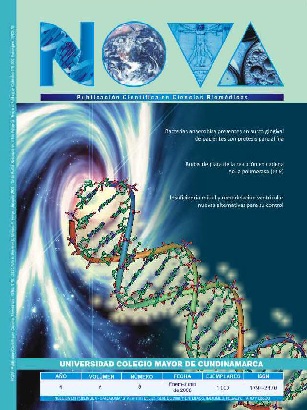Factores bióticos y abióticos que condicionan la biorremediación por Pseudomonas en suelos contaminados por hidrocarburos
Biotic and abiotic factors that condition the bioremediation by Pseudomonas in grounds contaminated by hydrocarbons

NOVA por http://www.unicolmayor.edu.co/publicaciones/index.php/nova se distribuye bajo una Licencia Creative Commons Atribución-NoComercial-SinDerivar 4.0 Internacional.
Así mismo, los autores mantienen sus derechos de propiedad intelectual sobre los artículos.
Mostrar biografía de los autores
El proceso de biorremediación de hidrocarburos, contaminantes del suelo, llevado a cabo por Pseudomonas sp. está condicionado por factores bióticos y abióticos como los nutrientes, respiración, pH, humedad y temperatura propios del microorganismo, los cuales al ser modificados limitan o favorecen la capacidad metabólica de la bacteria y su adaptabilidad con el cambio de posición de los ácidos grasos de la membrana celular. La biorremediación de suelos ha demostrado ser una tecnología eficaz para el tratamiento de la contaminación por petróleo, debido a que gran parte de los componentes del crudo y sus productos refinados son biodegradables. La presente revisión tiene por objetivo describir las condiciones bióticas y abióticas que necesitan las Pseudomonas para llevar a cabo un adecuado proceso de biorremediación, teniendo en cuenta las características y propiedades de la bacteria.
Visitas del artículo 671 | Visitas PDF 240
Descargas
- López JB, Quintero G, Guevara AL, Jaimes 1. DC, Gutiérrez SM, García J. Bioremediación de suelos contaminados con hidrocarburos derivados del petróleo. Nova. 2006;4:82-90.
- Ferrera R, Rojas N, Poggi HM, Alarcón A, Cañizares RO. Processes of bioremediation of soil and water which were contaminated by oil hydrocarbons and other organic substances. Rev Latinoam Microbiol. 2006; 48:179-187.
- Leahy JG, Colwell RR. Microbial Degradation of Hydrocarbons in Environment Microbiol Mol Biol Rev. 1990;54:305-315.
- Ivshina IB, Kuyukina MS, Philp JC, Christofi N. Oil desorption from mineral and organic materials using biosurfactant complexes produced by Rhodococcus sppecies. World J. Microbiol. Biotechnol. 1998;14:711-717.
- Mishra S, Jyot J, Kuhad RC, Lal B. Evaluation of inoculum addition to stimulate in situ bioremediation of oily-sludge-contaminated soil. Appl Environ Microbiol. 2001;67:1675-1681.
- Mc Dougald D, Rice S, Weichart D, Kjelleberg S. Nonculturability: adaptation or debilitation? FEMS Microbiol Ecol. 1998;25:1-9.
- Van Hamme JD, Singh A, Ward OP. Recent Advances in Petroleum Microbiology. Microbiol Mol Biol Rev. 2003;67:503-549.
- Marchal R, Pene S, Solano-Serena F, Vandecasteele JP. Gasoline and Diesel Oil Biodegradation. Oil & Gas Science and Technology. 2003;58: 441-448.
- Bracho M, Díaz L, Soto L. M. Biodegradación de hidrocarburos aromáticos policíclicos y heterocíclicos por Pseudomonas spp. Ciencia. 2004;12:269-275.
- Maroto ME, Rogel JM. Aplicación de sistemas de biorremediación de suelos y Aguas contaminadas por hidrocarburos. MMWR 2002. URL disponible en: http://aguas.igme.es/igme/publica/ pdflib15/028.pdf.
- Atlas RM. Petroleum microbiology. New York: Macmillan Publishing Co; 1984.
- Wilkinson S. G. Gram-negative bacteria. London: Academic Press; 1998.
- Atlas RM. Microbial degradation of petroleum hydrocarbons: an environmental perspective. Microbiol Rev. 1981; 45(1): 180–209.
- Viñas Canals Marc. Biorremediación de suelos contaminados por hidrocarburos: Caracterización microbiológica, química y ecotoxicológica. [Tesis Doctoral]. Barcelona: Universidad de Barcelona; 2005
- Llorente Miguel Isidro. Resumen del Manual de Edafología Disponible en: http://www.usal.es/~delcien/doc/FS.PDF. Consultado: 27 de Febrero de 2008.
- Foster L, Nannipieri P, Oades JM. Soil structure and biological activity. Disponible en: http://www.cababstractspplus.org/google/ abstract.aspp?AcNo=19971903099.html.
- Ortega Calvo JJ, Jiménez CS. Effect of humic fractions and clay on biodegradation of phenanthrene by a Pseudomonas fluorescens strain isolated from soil. Appl Environ Microbiol. 1998;64:3123–3126.
- Paul EA, Clark FE. Soil microbiology and biochemistry. San Diego: Academic Press; 1998.
- Bossert I, Bartha R. The fate of petroleum in soil ecosystems. In: R.M. Atlas Ed. Petroleum microbiology. New York: Macmillan Publishing Co; 1984. pg. 434-476.
- Atlas R M, Bartha R. Stimulated biodegradation of oil slicks using oleophilic fertilizers. Environ Sci Technol 1973;7:538-541.
- Mihelcic JR, Lueking DR, Mitzell RJ, Stapleton JM. Bioavailability of sorbed- and separate-phase chemicals. Biodegradation.1993;4:141–153.
- Schwarz JR, Walker JD, Colwell RR. Deep-sea bacteria: growth and utilization of n-hexadecane at in situ temperature and pressure. Can J Microbiol. 1975; 21:682-687.
- Jensen V. Bacterial flora of soil after application of oily waste. Oikos. 1975; 26:152-158.
- Pinholt Y, Struwe S, Kjoller A. Microbial changes during oil decomposition in soil. Ecography. 2006; 2:195-200.
- Lianos C, Kjoller A. Changes in the flora of soil fungi following oil waste application. Oikos. 1976;27:377-382.
- Rojas J, Moreno S, Rondón M. Biodegradación de gasoil rango Diesel por un cultivo mixto de bacterias. Ciencia. 2005;13:23-35.
- Sussman M, Collins CH, Skinner FA. Stewart DE. Release of genetically-engineered microorganisms. London: Academic Press; 1988.
- Atlas R. M., Busdosh. M. Microbial degradation of petroleum in the Arctic. En: Proceedings of the 3rd International Biodegradation Symposium. London: Applied Science Publishers Ltda; 1976. p. 79-86.
- Casellas M., Grifoll, M., Sabate J., Solanas A. M. Isolation and characterization of a 9- fluorenone-degrading bacterial strain and its role in synergistic degradation of fluorene by a consortium. Can J Microbiol. 1998; 44:734-742.
- Pérez S. Biodegradación del naftaleno por Pseudomona aeruginosa. AT18. Tecnología Química 2003; 23:21-27.
- Sayler GS, Shields MS, Tedford ET, Breen A, Hooper SW, Sirotkin
- KM, Davis JW. Application of DNA-DNA colony hybridization to the detection of catabolic genotypes in environmental samples. Appl Environ Microbiol. 1985;49:1295-1303.
- Ercoli E, Gálvez J, Di Paola M, Cantero J, Videla S, Medaura M, Bauzá J. Análisis y evaluación de parámetros críticos en biodegradación de hidrocarburos en suelo. Disponible en: http://
- www.eduardoercoli.com.ar/publicaciones/Param_criticos.pdf .
- Alexander M. Biodegradation and bioremediation. San Diego: Academic Press; 1994.
- Knaebel DB, Federle TW, McAvoy DC. Vestal JR. Effect of mineral and organic soil constituents on microbial mineralization of organic compounds in a natural soil. Appl Environ Microbiol. 1994;60:4500–4508.
- Chakrabarty AM. Plasmids in Pseudomonas. Annu Rev Genet. 1976;10:7-30.
- Van JR, Vos WM, Harayama S, Zehnder AJ. Molecular mechanisms of genetic adaptation to xenobiotic compounds. Microbiol Rev. 1992;56:677-694.
- Nelson KE, Weinel C, Paulsen IT, Dodson RJ, Hilbert H, Martins VA, Fouts DE, y col. Complete genome sequence and comparative analysis of the metabolically versatile Pseudomonas putida KT2440. Environ Microbiol. 2002; 4:799-808.
- Demanèche S, Kay E, Gourbière F, Simonet P. Natural transformation of Pseudomonas fluorescens and Agrobacterium tumefaciens in soil. Appl Environ Microbiol. 2001; 67:2617-2621.
- Deziel E, Paquette G, Villemur R, Lepine F, Bisaillon J. Biosurfactant Production by a Soil Pseudomonas Strain Growing on Polycyclic Aromatic Hydrocarbons. Applied and environmental microbiology.1996;62:1908-1912.
- Hommel RK. Formation and physiological role of biosurfactants produced by hydrocarbon-utilizing microorganisms. Biodegradation. 1990;1:107–119.
- Tissot B, Welte DH. Petroleum formation and occurrence. New York USA: Sppringer-Verlang; 1984.
- Kästner M, Mahro B. Microbial degradation of polycyclic aromatic hydrocarbons in soils affected by the organic matrix of
- compost. Appl Microbiol Biotechnol.1996;44:668–675.
- White K. L. An overview of immunotoxicology and carcinogenic polycyclic aromatic hydrocarbons. Environ Carcinogen Rev. m1986;4:163–202.
- Daane LL, Harjono I, Zylstra GJ, Häggblom MM. Isolation and characterization of polycyclic aromatic hydrocarbon-degrading bacteria associated with the rhizospphere of salt marsh plants. Appl Environ Microbiol. 2001;67:2683-2691.
- Volke T, Velasco J. Biodegradación de hidrocarburos del petróleo en suelos intemperizados mediante composteo. Disponible en: http:// www.ine.gob.mx/dgcenica/descargas/composteo2003.pdf.
- Adam R, Domínguez V, García L. Potencial de la Biorremediación de suelo y agua impactados por petróleo en
- el trópico Mexicano. Disponible en: www.chapingo.mx/terra/ contenido/17/2/art159-174.pdf.
- Zhongqi H, Sppain J. Studies of the catabolic pathway of degradation of nitrobenzene by Pseudomonas pseudoalcaligenes JS45: Removal of the Amino Group from 2-Aminomuconic Semialdehyde. Appl Environ Microbiol. 1997;63:4839–4843.
- Walker JD, Petrakis L, Colwell RR. Comparison of the biodegradability of crude and fuel oils. Can J Microbiol. 1976;22:598-602. 49. Suflita JM, Horowitz A, Shelton DR, Tiedje JM. Dehalogenation: a novel pathway for the anaerobic biodegradation of haloaromatic compounds. Science. 1982;218:1115-1117.
- Dibble JT, Bartha R. Effect of environmental parameters on the biodegradation of oil sludge. Appl Environ Microbiol. 1979;37:729-739.
- Swindoll C, Michael C, Aelion M, Pfaender F. Influence of inorganic and organic nutrients on aerobic biodegradation and on the adaptation respponse of subsurface microbial communities. Appl Environ Microbiol. 1988;54:212-217.
- Cantwell SG, Lau EP, Watt DS, Fall RR. Biodegradationmof acyclic isoprenoids by Pseudomonas species. J Bacteriol. 1978;135:324-333.
- Pardo JL, Perdomo MC, Benavides JL. Efecto de la adición
- de fertilizantes inorgánicos compuestos en la degradación de hidrocarburos en suelos contaminados con petróleo. NOVA. 2004;2:40-49.
- Krieg NR, Holt JG. Bergey´s Manual of Sistematic Bacteriology. Ed. Williams y Wilkings. Baltimor, U.S.A. 1984;1:141–199.
- Pineda G, Mesta AM. Petroleum aspphaltenes: generated problematic and possible biodegradation mechanisms. Rev Latinoam Microbiol. 2001;43: 143-150.
- Pereira JN, Morgan ME. Nutrition and physiology of Pseudomonas fragi. J Bacteriol. 1957;74:710–713.
- Pellini A. Biorremediación estimulada por efluentes cloacales tratados de suelos contaminados con hidrocarburos. Disponible en: http://www.tesis.bioetica.org/lp.htm .
- González R, Monroy M, Mier MV. Estudio de biorremediación de suelos contaminados con Tetracloroetileno. En: XXXVI Congreso Mexicano de Química. México Universidad Autónoma Metropolitana-Azcapotzalco: Sociedad Química de México, A.C; 2001. pg. 225-230.
- Perry JJ. Microbial cooxidations involving hydrocarbons. Microbiol Rev 1979;43:59-72.
- Eweis JB, Ergas SJ, Chang DP, Schroeder ED. Principios de Biorrecuperación: Tratamientos para la descontaminación y regeneración de suelos y aguas subterráneas mediante procesos biológicos y fisicoquímicos. Madrid: 1999. Adams RH, Armenta G, García L. Bioremediation 61. in the petroleum producing region of southeast Mexico: En: Second Inter-American Environmental Congress. México: Instituto Tecnológico y de Estudios Superiores de Monterrey (ITESM); 1995.
- Adams R, Domínguez V, Garciá L. Bioremediation Potential of Oil Impacted Soil and Water in the Mexican Tropics. Terra Latin. 1999;17: 25-28.
- Kincannon, CB. Oily waste dispposal by soil cultivation process. Dispponible en: http://www.amazon.com/dispposal-cultivation-Environmental-protection-technology.html .
- EPA. Bioremediation of Hazardous Waste Sites: Dispponible en:http://www.epa.gov/nrmrl/pubs/625k96001/625k96001.pdf .
- Hambrick GA, DeLaune RD, Patrick WH. Effect of
- estuarine sediment pH and oxidation-reduction potential on microbial hydrocarbon degradation. Appl Environ Microbiol. 1980;40:365-369.
- Stapleton RD. Biodegradation of aromatic hydrocarbons in an extremely acidic environment. Appl Environ Microbiol. 1998;64:4180-4184.
- Staunton S. Effect of pH and some organic anions on the solubility of soil phospphate: implications for P bioavailability. Eur J Soil Sci. 1996;47: 231–239. 68. Singh BK, Walker A, Morgan JA, Wright DJ. Effects of soil
- pH on the biodegradation of chlorpyrifos and isolation of a chlorpyrifos-degrading bacterium. Appl Environ Microbiol. 2003ç ;69:5198-51206. 69. Sharpley AN. Efect of soil pH on cation and anion solubility. Commun Soil Sci Plant Anal. 1991;22:1391-1399.
- Reynolds ES. The use of lead citrate at high pH as an electron opaque strain in electron microscopy. J Cell Biol.
- ;17:208-212.
- Baker KH. Bioremediation of surface and subsurface soils. New York: McGraw-Hill; 1994
- Verstraete WR, Vanloocke R, De Borger R, Verlinde A. Modeling of the breackdown and the molbilization of hydrocarbons in unsaturated soil layers. En: Proceedings of the 3rd International Biodegradation Symposium.London Applied Science Publishers; 1976 .p. 98-112.
- Haigler BE, Pettigrew CA, Sppain JC. Biodegradation of mixtures of substituted benzenes by Pseudomonas strain JS150. Appl Environ Microbiol. 1992;58:2237–2244.
- Keel C, Weller DM, Natsch A, Defago G, Cook RJ. Thomashow LS. Conservation of the 2,4-diacetylphloroglucinol biosynthesislocus among fluorescent Pseudomonas strains from diverse geographic locations. Appl Environ Microbiol. 1996;62:552–563.
- Kerry E. Microorganism colonizing plants and soil subjected to different degrees of human activity, including petroleum contamination in the Vestfold Hills and MacRobertson Land Antarctica. Polar Biol. 1990;10:423-430.
- Pucci GN, Härtig C, Pucci OH. Influence of salinity and temperature on fatty acid composition of Pseudomonas fluorescens GNP-OHP-3 membrane. Rev Argent Microbiol. 2004;36:6-15.
- -----------------------------------------------------------------------------------
- DOI: http://dx.doi.org/10.22490/24629448.398





